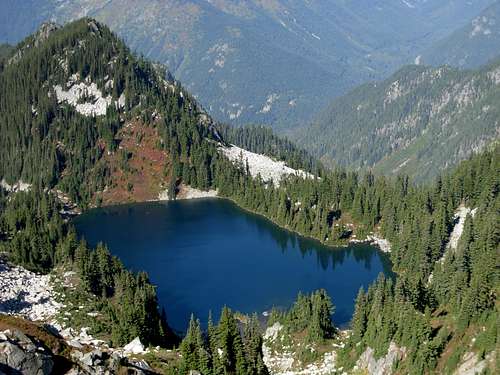|
|
Mountain/Rock |
|---|---|
|
|
47.65956°N / 121.15565°W |
|
|
King |
|
|
Hiking, Mountaineering, Scrambling |
|
|
Spring, Summer, Fall, Winter |
|
|
6311 ft / 1924 m |
|
|
Overview
Spark Plug Mountain is an alpine peak nestled in the middle of the Alpine Lakes Wilderness of Washington State. Perhaps appropriately, several alpine lakes are found near the mountain. Surprise Lake and Glacier Lake are both located east of the mountain, and Spark Plug Lake and Little Plug Lake are both located north of the mountain. Views of surrounding peaks and valleys from the mountain are also far-reaching, including Mount Daniel, Mount Sawyer (Tonga Ridge), and Glacier Peak. Spark Plug Mountain is immediately located northwest of Surprise Mountain and west of Thunder Mountain.
The summit of Spark Plug Mountain has a U.S. Geological Society survey marker, placed there in 1937. The marker calls the point "King Spark Plug", signifying the highest of the various peaks along the mountaintop. The "Mountaineers" organization placed a register at the summit in 2001, with an average of only 5-10 people signing it each year.
Paths for climbing Spark Plug Mountain begin at Pieper Pass (6000’), a saddle connecting the mountain to Surprise Mountain. Directions to Pieper Pass are listed in the "Getting There" section on this page. From Pieper Pass a mountaineer can follow routes to the summits of Spark Plug Mountain and Surprise Mountain, or continue along the Pacific Crest Trail (PCT). From Pieper Pass there are two paths leading up Spark Plug Mountain from its south end. One path begins by leading around the western slope of the mountain, initially offering modest elevation gain with no scenic views. The other path, on the other hand, steeply ascends to and across the first minor peaks of the mountaintop and offers wonderful scenic views of the surrounding landscapes. Both paths eventually rejoin each other along the ridgetop. However, due to the limited use and rugged terrain, the summit path will tend to disappear and be overgrown in many places. Routefinding and scrambling abilities are necessary to complete the summit ascent.
Multiple false summits are on the mountaintop, with each false summit becoming more technical than the last one passed. The final false summit is a vertical slab of granite that can only be steeply climbed over its top or carefully traversed around its eastern side using what appears to be a faint animal path. Use caution along the final slopes; the ground is steep with loose dirt and rock. Holding onto tree branches and/or brush might be necessary. The true summit (6311’) is located shortly after the final false summit. The distance from Pieper Pass to the summit of Spark Plug Mountain is approximately 1.0 mile.
Getting There
NOTE: This mountain is found on Green Trails Map #176.Spark Plug Mountain has multiple routes leading to it:
Two major routes originate north of the mountain:
1) Surprise Creek Trail #1060, beginning at the community of Scenic, Washington south of Highway 2.
Follow Surprise Creek Trail #1060 south for 4.7 miles.
Then follow the Pacific Crest Trail (PCT) #2000 south for approximately 2.3 miles to Pieper Pass.
***NOTE: This route is the most direct established route to the summit of Spark Plug Mountain from a parking trailhead.***
2) Pacific Crest Trail #2000, beginning at the PCT Trailhead located at Stevens Pass, Washington south of Highway 2.
Follow the PCT south for approximately 16 miles to Pieper Pass.
------------
Two major routes originate west of the mountain:
1) Fisher Creek Trail #1059.1, also known as the Deception Creek Cut-Off Trail, beginning near the end of Forest Road 6830 (south of Foss River Road, east of Skykomish, Washington).
Follow Deception Creek Cut-Off Trail #1059.1 east for 0.7 miles.
Then follow Deception Creek Trail #1059 south for 2.5 miles.
Then follow Deception Lakes Trail #1059.2 east for 0.8 miles.
Then follow Deception Lakes Trail #1059.A (section of PCT) north for 0.4 miles.
Then follow PCT north for 1.6 miles to Pieper Pass.
***NOTE: This route has the least hiking distance (7.0 miles) to the summit of Spark Plug Mountain from a parking trailhead.***
2) Deception Creek Trail #1059, beginning at Forest Road 6088 (near Deception Falls) south of Highway 2.
Follow Deception Creek Trail #1059 south for 7.3 miles.
Then follow Deception Lakes Trail #1059.2 east for 0.8 miles.
Then follow Deception Lakes Trail #1059.A (section of PCT) north for 0.4 miles.
Then follow PCT north for 1.6 miles to Pieper Pass.
------------
The only major route originating south of the mountain is the PCT, heading north from Deception Pass, which is not a parking trailhead. Follow PCT north 5.5 miles from Deception Pass to Pieper Pass.
Red Tape
ALL visitors to the the Alpine Lakes Wilderness are required to have a Wilderness Permit from May 15 to October 31. Wilderness permits are free and can be obtained at trailheads and local ranger stations.*If parking a vehicle in the region, the trailheads within the Alpine Lakes Wilderness require a Northwest Forest Pass. A single-day Northwest Forest Pass costs $5, while an annual Northwest Forest Pass costs $30. Northwest Forest Passes can be purchased from ranger stations or REI stores (if not also other outdoor recreation stores) within Washington State.
Camping
Although several rugged campsites are found at various locations around Spark Plug Mountain, such as at Glacier Lake and the small open valley southeast of the mountain, camping in these locations is NOT permitted.The closest permitted (designated) campsite near Spark Plug Mountain is located northeast of the peak, near Surprise Lake.





